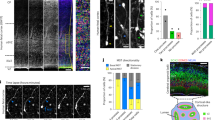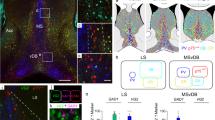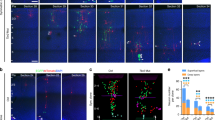Abstract
Cajal-Retzius cells are critical in cortical lamination, but very little is known about their origin and development. The homeodomain transcription factor Dbx1 is expressed in restricted progenitor domains of the developing pallium: the ventral pallium (VP) and the septum. Using genetic tracing and ablation experiments in mice, we show that two subpopulations of Reelin+ Cajal-Retzius cells are generated from Dbx1-expressing progenitors. VP- and septum-derived Reelin+ neurons differ in their onset of appearance, migration routes, destination and expression of molecular markers. Together with reported data supporting the generation of Reelin+ cells in the cortical hem, our results show that Cajal-Retzius cells are generated at least at three focal sites at the borders of the developing pallium and are redistributed by tangential migration. Our data also strongly suggest that distinct Cajal-Retzius subtypes exist and that their presence in different territories of the developing cortex might contribute to region-specific properties.
This is a preview of subscription content, access via your institution
Access options
Subscribe to this journal
Receive 12 print issues and online access
$209.00 per year
only $17.42 per issue
Buy this article
- Purchase on Springer Link
- Instant access to full article PDF
Prices may be subject to local taxes which are calculated during checkout






Similar content being viewed by others
References
Marin-Padilla, M. Cajal-Retzius cells and the development of the neocortex. Trends Neurosci. 21, 64–71 (1998).
Kriegstein, A.R. & Noctor, S.C. Patterns of neuronal migration in the embryonic cortex. Trends Neurosci. 27, 392–399 (2004).
Marin, O. & Rubenstein, J.L. Cell migration in the forebrain. Annu. Rev. Neurosci. 26, 441–483 (2003).
Meyer, G., Goffinet, A.M. & Fairen, A. What is a Cajal-Retzius cell? A reassessment of a classical cell type based on recent observations in the developing neocortex. Cereb. Cortex 9, 765–775 (1999).
Zecevic, N. & Rakic, P. Development of layer I neurons in the primate cerebral cortex. J. Neurosci. 21, 5607–5619 (2001).
D'Arcangelo, G. et al. A protein related to extracellular matrix proteins deleted in the mouse mutant reeler. Nature 374, 719–723 (1995).
Ogawa, M. et al. The reeler gene-associated antigen on Cajal-Retzius neurons is a crucial molecule for laminar organization of cortical neurons. Neuron 14, 899–912 (1995).
Super, H., Del Rio, J.A., Martinez, A., Perez-Sust, P. & Soriano, E. Disruption of neuronal migration and radial glia in the developing cerebral cortex following ablation of Cajal-Retzius cells. Cereb. Cortex 10, 602–613 (2000).
Del Rio, J.A. et al. A role for Cajal-Retzius cells and reelin in the development of hippocampal connections. Nature 385, 70–74 (1997).
Alcantara, S. et al. Regional and cellular patterns of reelin mRNA expression in the forebrain of the developing and adult mouse. J. Neurosci. 18, 7779–7799 (1998).
Hevner, R.F., Neogi, T., Englund, C., Daza, R.A. & Fink, A. Cajal-Retzius cells in the mouse: transcription factors, neurotransmitters, and birthdays suggest a pallial origin. Brain Res. Dev. Brain Res. 141, 39–53 (2003).
Gorski, J.A. et al. Cortical excitatory neurons and glia, but not GABAergic neurons, are produced in the Emx1-expressing lineage. J. Neurosci. 22, 6309–6314 (2002).
Shinozaki, K. et al. Absence of Cajal-Retzius cells and subplate neurons associated with defects of tangential cell migration from ganglionic eminence in Emx1/2 double mutant cerebral cortex. Development 129, 3479–3492 (2002).
Meyer, G. & Wahle, P. The paleocortical ventricle is the origin of reelin-expressing neurons in the marginal zone of the foetal human neocortex. Eur. J. Neurosci. 11, 3937–3944 (1999).
Meyer, G., Perez-Garcia, C.G., Abraham, H. & Caput, D. Expression of p73 and Reelin in the developing human cortex. J. Neurosci. 22, 4973–4986 (2002).
Lavdas, A.A., Grigoriou, M., Pachnis, V. & Parnavelas, J.G. The medial ganglionic eminence gives rise to a population of early neurons in the developing cerebral cortex. J. Neurosci. 19, 7881–7888 (1999).
Takiguchi-Hayashi, K. et al. Generation of reelin-positive marginal zone cells from the caudomedial wall of telencephalic vesicles. J. Neurosci. 24, 2286–2295 (2004).
Jessell, T.M. Neuronal specification in the spinal cord: inductive signals and transcriptional codes. Nat. Rev. Genet. 1, 20–29 (2000).
Schuurmans, C. & Guillemot, F. Molecular mechanisms underlying cell fate specification in the developing telencephalon. Curr. Opin. Neurobiol. 12, 26–34 (2002).
Campbell, K. Dorsal-ventral patterning in the mammalian telencephalon. Curr. Opin. Neurobiol. 13, 50–56 (2003).
Lu, S., Bogarad, L.D., Murtha, M.T. & Ruddle, F.H. Expression pattern of a murine homeobox gene, Dbx, displays extreme spatial restriction in embryonic forebrain and spinal cord. Proc. Natl. Acad. Sci. USA 89, 8053–8057 (1992).
Shoji, H. et al. Regionalized expression of the Dbx family homeobox genes in the embryonic CNS of the mouse. Mech. Dev. 56, 25–39 (1996).
Pierani, A., Brenner-Morton, S., Chiang, C. & Jessell, T.M. A sonic hedgehog-independent, retinoid-activated pathway of neurogenesis in the ventral spinal cord. Cell 97, 903–915 (1999).
Pierani, A. et al. Control of interneuron fate in the developing spinal cord by the progenitor homeodomain protein Dbx1. Neuron 29, 367–384 (2001).
Lanuza, G.M., Gosgnach, S., Pierani, A., Jessell, T.M. & Goulding, M. Genetic identification of spinal interneurons that coordinate left-right locomotor activity necessary for walking movements. Neuron 42, 375–386 (2004).
Yun, K., Potter, S. & Rubenstein, J.L. Gsh2 and Pax6 play complementary roles in dorsoventral patterning of the mammalian telencephalon. Development 128, 193–205 (2001).
Medina, L. et al. Expression of Dbx1, Neurogenin 2, Semaphorin 5A, Cadherin 8, and Emx1 distinguish ventral and lateral pallial histogenetic divisions in the developing mouse claustroamygdaloid complex. J. Comp. Neurol. 474, 504–523 (2004).
Zinyk, D.L., Mercer, E.H., Harris, E., Anderson, D.J. & Joyner, A.L. Fate mapping of the mouse midbrain-hindbrain constriction using a site-specific recombination system. Curr. Biol. 8, 665–668 (1998).
de Carlos, J.A., Lopez-Mascaraque, L. & Valverde, F. Dynamics of cell migration from the lateral ganglionic eminence in the rat. J. Neurosci. 16, 6146–6156 (1996).
Corbin, J.G., Nery, S. & Fishell, G. Telencephalic cells take a tangent: non-radial migration in the mammalian forebrain. Nat. Neurosci. 4, 1177–1182 (2001).
Marin, O. & Rubenstein, J.L. A long, remarkable journey: tangential migration in the telencephalon. Nat. Rev. Neurosci. 2, 780–790 (2001).
Tronche, F. et al. Disruption of the glucocorticoid receptor gene in the nervous system results in reduced anxiety. Nat. Genet. 23, 99–103 (1999).
Tamamaki, N., Fujimori, K.E. & Takauji, R. Origin and route of tangentially migrating neurons in the developing neocortical intermediate zone. J. Neurosci. 17, 8313–8323 (1997).
Ang, E.S., Jr ., Haydar, T.F., Gluncic, V. & Rakic, P. Four-dimensional migratory coordinates of GABAergic interneurons in the developing mouse cortex. J. Neurosci. 23, 5805–5815 (2003).
Hevner, R.F. et al. Tbr1 regulates differentiation of the preplate and layer 6. Neuron 29, 353–366 (2001).
Mallamaci, A. et al. The lack of Emx2 causes impairment of Reelin signaling and defects of neuronal migration in the developing cerebral cortex. J. Neurosci. 20, 1109–1118 (2000).
Mallamaci, A., Muzio, L., Chan, C.H., Parnavelas, J. & Boncinelli, E. Area identity shifts in the early cerebral cortex of Emx2−/− mutant mice. Nat. Neurosci. 3, 679–686 (2000).
Borrell, V. et al. Reelin regulates the development and synaptogenesis of the layer-specific entorhino-hippocampal connections. J. Neurosci. 19, 1345–1358 (1999).
Meyer, G., Soria, J.M., Martinez-Galan, J.R., Martin-Clemente, B. & Fairen, A. Different origins and developmental histories of transient neurons in the marginal zone of the fetal and neonatal rat cortex. J. Comp. Neurol. 397, 493–518 (1998).
Meyer, G. et al. Developmental roles of p73 in Cajal-Retzius cells and cortical patterning. J. Neurosci. 24, 9878–9887 (2004).
Aboitiz, F., Montiel, J. & Lopez, J. Critical steps in the early evolution of the isocortex: insights from developmental biology. Braz. J. Med. Biol. Res. 35, 1455–1472 (2002).
Palmiter, R.D. et al. Cell lineage ablation in transgenic mice by cell-specific expression of a toxin gene. Cell 50, 435–443 (1987).
Lee, K.J., Dietrich, P. & Jessell, T.M. Genetic ablation reveals that the roof plate is essential for dorsal interneuron specification. Nature 403, 734–740 (2000).
Cohen-Tannoudji, M. et al. I-SceI-induced gene replacement at a natural locus in embryonic stem cells. Mol. Cell. Biol. 18, 1444–1448 (1998).
Hippenmeyer, S. et al. A developmental switch in the response of DRG neurons to ETS transcription factor signaling. PLoS Biol. 3, e159 (2005).
Schiffmann, S.N., Bernier, B. & Goffinet, A.M. Reelin mRNA expression during mouse brain development. Eur. J. Neurosci. 9, 1055–1071 (1997).
Lu, S., Wise, T.L. & Ruddle, F.H. Mouse homeobox gene Dbx: sequence, gene structure and expression pattern during mid-gestation. Mech. Dev. 47, 187–195 (1994).
Wilkinson, D.G., Bhatt, S., Ryseck, R.P. & Bravo, R. Tissue-specific expression of c-jun and junB during organogenesis in the mouse. Development 106, 465–471 (1989).
Acknowledgements
We are indebted to T.M. Jessell for having made this work possible. We thank K. Campbell for suggesting that Dbx1 progenitors give rise to Cajal-Retzius cells; M. Sunshine and D. Littman for helping in the generation of the Dbx1loxP-stop-loxP-DTA mouse line; A. Nemes and M. Mendelsohn for embryonic stem cell transfection and injection of the Dbx1Cre line; F. Tronche for providing the Nes:CRE mouse line, D. Anderson for the βactin:loxP-stop-loxP-lacZ mice and A. Goffinet for the G10 anti-Reelin monoclonal antibodies; M. Cohen-Tannoudji and F. Jaisser for the I-SceI-induced gene replacement system; P. Alexandre and R. Goiame for technical help and advice and M. Ensini, S. Garel, C. Goridis, T.M. Jessell and O. Marin for comments on the manuscript. F.B. was the recipient of a fellowship from the Académie Nationale de Médecine (France). S.A. and M.S. were supported by a grant from the Swiss National Science Foundation, by the Kanton of Basel-Stadt and by the Novartis Research Foundation. A.P. and M.W. are CNRS (Centre National de la Recherche Scientifique) Investigators. This work was supported by the Ministère de la Recherche (ACI grant # 0220575) and the Association pour la Recherche sur le Cancer (grant # 4679) to A.P.
Author information
Authors and Affiliations
Corresponding author
Ethics declarations
Competing interests
The authors declare no competing financial interests.
Supplementary information
Supplementary Fig. 1
Dbx1-derived cells are highly motile and populate preferentially rostral and caudo-ventral regions of the developing cortex up to E12.5. (PDF 19163 kb)
Supplementary Fig. 2
Temporal and spatial distribution of cell death in Dbx1DTA;Nes:Cre embryos. (PDF 27191 kb)
Supplementary Fig. 3
Novel sources of Cajal-Retzius cells and their different distribution in cortical regions. (PDF 4289 kb)
Rights and permissions
About this article
Cite this article
Bielle, F., Griveau, A., Narboux-Nême, N. et al. Multiple origins of Cajal-Retzius cells at the borders of the developing pallium. Nat Neurosci 8, 1002–1012 (2005). https://doi.org/10.1038/nn1511
Received:
Accepted:
Published:
Issue Date:
DOI: https://doi.org/10.1038/nn1511
This article is cited by
-
Transcriptionally defined amygdala subpopulations play distinct roles in innate social behaviors
Nature Neuroscience (2023)
-
Aberrant survival of hippocampal Cajal-Retzius cells leads to memory deficits, gamma rhythmopathies and susceptibility to seizures in adult mice
Nature Communications (2023)
-
Transcriptomes of electrophysiologically recorded Dbx1-derived respiratory neurons of the preBötzinger complex in neonatal mice
Scientific Reports (2022)
-
Fate mapping reveals mixed embryonic origin and unique developmental codes of mouse forebrain septal neurons
Communications Biology (2022)
-
Single cell transcriptome sequencing of inspiratory neurons of the preBötzinger complex in neonatal mice
Scientific Data (2022)



